- Quick Read
- Deep Read ( 17 Min. )
Monitor Daily Podcast
- Follow us:
- Apple Podcasts
- Spotify
- RSS Feed
- Download
TODAY’S INTRO
The Climate Generation, a major Monitor series
 Mark Sappenfield
Mark Sappenfield
Not long ago, we asked if the dramatic disruptions to normal weather patterns around the world might soon bring a tipping point in public opinion. Today, we offer one answer.
Below is the first installment in our series about what we’re calling the Climate Generation. For many young people who have grown up amid the climate crisis, the tipping point is well past. From Namibia to the Canadian Arctic, they are at the forefront of seeking solutions. Their stories are not ones of despair, but ones of grounded optimism and resolve.
Share this article
Link copied.

Help fund Monitor journalism for $11/ month
Already a subscriber? Login

Monitor journalism changes lives because we open that too-small box that most people think they live in. We believe news can and should expand a sense of identity and possibility beyond narrow conventional expectations.
Our work isn't possible without your support.
The Climate Generation
Climate change is driving a global youth revolution
Our new solutions series about the global climate crisis represents a huge investment on our part. We sent our reporters to the farthest corners of the world. Why? Climate is the subject of so much despondence and division. Through the eyes of these young people, however, we see a different picture – neither as simplistic as we often hear, nor as hopeless.

-
Stephanie Hanes Staff writer
The Climate Generation looks like Atlas Sarrafoğlu, a Turkish 16-year-old with a shy smile, Nike high tops, and a cardboard sign of accusation: “Your mistakes, our future.” He filed a lawsuit this year against his government, hoping to force the grown-ups to pay attention to the nation’s carbon emissions.
Our Monitor team met Atlas and dozens of young people shaping what it means to live in a world altered by a changing climate. From the gleaming financial capital of Frankfurt to the sea-breeze coasts of Barbados, big-sky Montana to the waterlogged streets of Bangladesh, sunny rural Portugal to the windblown ice of the Arctic, a breathtaking transformation is underway.
Climate change is fueling a mindset revolution led by a younger generation seizing opportunity in the extremity of the crisis. Spectacularly connected across continents, this Climate Generation – those born since 1989, when children’s rights and climate change began to intersect – is shaping a global ethos that’s possibly the most hopeful answer to the heating planet.
“The solution to the problem is in their hands,” said the late Saleemul Huq, a Bangladeshi expert on climate change and sustainable development, who died unexpectedly just before press time. “While there are many other ways of dissecting this global issue ... the older generation v. the younger generation is by far the most significant one.”
Climate change is driving a global youth revolution
Listen to the full story, read by its editor
The Climate Generation looks like Atlas Sarrafoğlu, a boyish 16-year-old with a shy smile, Nike high tops, and a cardboard sign of accusation: “Your mistakes, our future.” He has it resting next to him by a park bench in Istanbul along the banks of the Bosporus, where growing up he played soccer and listened to rap music.
The sign, in some ways, is the easiest of his protests in his authoritarian-leaning country. Earlier this year, the teen filed a lawsuit against the Turkish government demanding it fulfill the commitment it made, along with most of the world, to lower the amount of heat-trapping gases it sends into the atmosphere.
Maybe a court action, he hoped, would make the grown-ups pay attention. He knew other young people had tried that in their countries.

Six thousand miles across the Atlantic, Natalie Yocum glances up from the banks of the Bitterroot River and checks out the haze thickening over the mountains north of Missoula, Montana. She inhales.
“It smells like cross-country season,” the 22-year-old says, and then gives a quick, embarrassed laugh. It feels wrong to be nostalgic about smoke. But in the American West, wildfires have burned through childhood.
Ms. Yocum knows from the alerts on her phone that this July 2023 blaze is not contained, and that it is moving closer to where she and her parents live, north of Missoula, in the big-sky town of Arlee, population 592. She once volunteered on a firefighting chain saw crew, and she knows many of the people who are monitoring the situation. But after a quick glance at the horizon, she turns back to measuring water quality. It will take many people doing lots of little things, she believes, like this fieldwork she is doing as a volunteer for a local nonprofit, to slow climate change.
Jakapita Kandanga, a 26-year-old Namibian climate activist, is also working to respond to the world’s increasingly disrupted weather patterns, from floods and droughts to heat waves and fires. She has felt the impact of these changes. During her childhood, when the rains stopped in rural Namibia, Ms. Kandanga’s father couldn’t sell his cattle – and she couldn’t attend school.
She doesn’t want anyone else to ever experience this. That’s why she’s gotten up on a Saturday morning to teach a bunch of children in an informal settlement outside the Namibian capital Windhoek about what climate change is.

“I just want that everybody has equal resources to survive the climate crisis,” she says. Everyone should have access to education, she adds: “Everyone should have the tools to survive.”
We met Atlas, Natalie, and Jakapita this past year, along with dozens of other young people who are shaping what it means to live in a world altered by a changing climate.
Originally, we sought them out because we were interested in a paradox: Today’s young people were born into an unprecedented era of children’s rights, a time when most of the world agrees that young people are entitled to things like a safe home, the ability to go to school, and the freedom from physical harm. Yet at the same time, this Climate Generation, as we are calling it, has come of age in an era of unprecedented challenge, and is confronting the overwhelming reality of a changing, heating, disrupted world.
Both of us have written extensively about children, from many angles and many parts of the world. We are also the mothers of daughters on the cusp of young adulthood. We’d been hearing a lot, personally and professionally, about young people’s mental health struggles with climate change – in and of itself a new phenomenon.
A recent study led by Caroline Hickman, a researcher at the University of Bath in England, shows how youth across the world feel similar levels of eco-anxiety. Almost half of young people in Africa said they have reconsidered having children due to climate change, according to a UNICEF poll.
“The difference is generational rather than [by] countries,” says Ms. Hickman. “And that is stronger than gender ... economic background ... politics – stronger than anything.”
Still, we suspected there was more than gloom and doom to the Climate Generation’s shared experience of a changing world. So, for the past year, the two of us have traveled around the globe to talk to them.
And it turns out there is much more.

From the gleaming financial capital of Frankfurt to the sea-breeze coasts of Barbados, from the big skies of Montana to the waterlogged streets of Bangladesh, from the sunny countryside of Portugal to the windblown ice of the Arctic, a breathtaking transformation is underway.
Climate change is shaping a mindset revolution.
If the Industrial Revolution rippled across the globe and human consciousness with new definitions of progress, time, responsibility, and work, the climate crisis is redefining those conceptions. In our travels, we met innovators and regenerators, activists and adapters, conservationists and challengers. All of them, in their own ways, are pushing back against the silos in which we’ve understood our world in industry, environment, or geography. They are seizing on a crisis moment to tackle the inequalities and injustices that have long saddled their nations – crafting a new ethos about consumption, “progress,” and what it means to have a good life.
We define the Climate Generation as those born in or after 1989, when the United Nations Convention on the Rights of the Child was adopted. It has since been ratified by every country in the world, except the United States.
That year also marked the first time the world surpassed what scientists call a safe concentration of atmospheric carbon dioxide, a heat-trapping gas largely responsible for the warming and related climatic changes we see today.
Individually, the stories of these young people can seem small, like pinpricks of light flickering against a supercharged storm of politics-as-usual, economic and cultural norms, and a global inclination to avoid the realities of climate change. But as we met more people, we realized that very little the Climate Generation does is truly isolated; this is a generation that is spectacularly connected.

A young couple who farms in the dusty interior of Portugal shares what they’ve learned about climate adaptation to an international Instagram following. A young scientist in Barbados working on biofuel production travels to California to work with other young researchers. Atlas, the teen from Turkey, turns out to be friends with the climate activist we wanted to meet in Namibia, who in turn talks about her admiration for the organizer we went to Bangladesh to interview.
And it is this connectedness, researchers say, along with the Climate Generation’s shifts in perspective and behavior, that may well be the most hopeful answer yet to a heating world.
“The solution to the problem is in their hands,” said the late Saleemul Huq, a Bangladeshi expert on climate change and sustainable development, who died unexpectedly just before press time. “And while there are many other ways of dissecting this global issue – North vs. South, rich vs. poor – to me, the older generation vs. the younger generation is by far the most significant one.”
A powerful web of global connection
Social revolutions are as tricky to pinpoint as climate change itself. Think back to when you first started using email or a smartphone, wireless earbuds, Netflix, or same-day delivery. For most of us of a certain age, there was no one day when we woke up and noticed that we were part of a technological revolution. But we were.
Our individual actions – jobs, purchases, preferences, expectations, and mindsets – wove that revolution into the fabric of our collective existence.
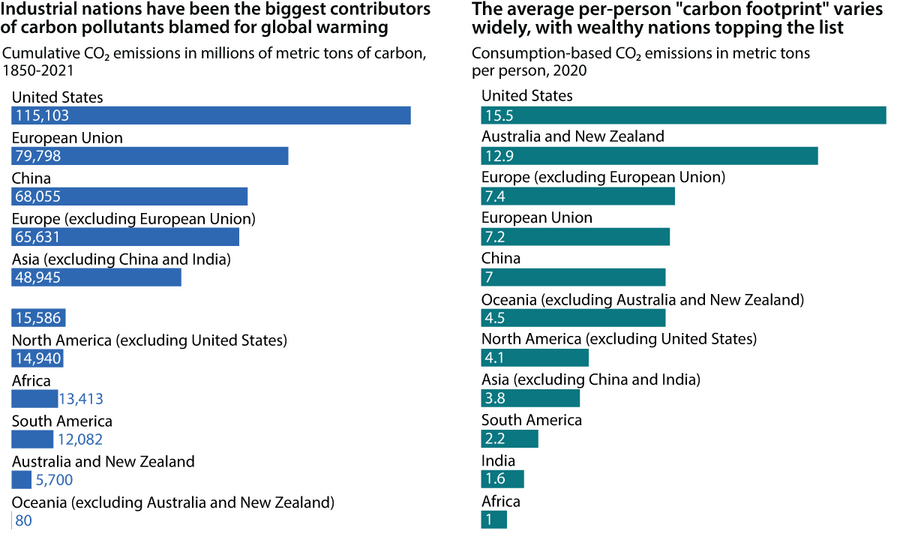
SOURCE: Global Carbon Budget 2022
Climate change is similar. For decades, scientists have warned about “anthropogenic climate change,” a term we realize is pretty much meaningless to most readers. Even the words “climate change” are often misunderstood or filled with either mistrust or a certain anxiety.
But the technological revolution – once an amorphous, frothy concept itself, laden with dreams and dire forecasts – has now shifted tangible parts of the mundane elements in our lives. Likewise, the environmental disruptions connected to our heating world are also beginning to change our everyday lives.
Sometimes it’s dramatic. This past year saw a cascade of extreme weather events: ice storms in Texas, unusually long-lived cyclones that killed hundreds in southeast Africa, Canadian wildfires that turned New York City opaque, and heat waves that helped make this summer the hottest ever recorded. But it can also be nearly imperceptible: the slow migration of maple trees northward, humidity that lasts a few days longer, storm drains that regurgitate seawater during high tides.

The Climate Generation revolution follows a similar pattern.
There are the individuals who seize headlines and inspire others. Swedish teenager Greta Thunberg captured international attention when she protested outside the Swedish parliament, week after week, throughout the 2018 school year. The international activist group that she inspired, Fridays for Future, would soon motivate many thousands of youth across the world to demand government action in response to their heating world. In September 2019, an estimated 4 million schoolchildren protested during the Global Week for Future.
It’s easy to forget just how big this movement was becoming when the pandemic shut down public gatherings in early 2020.
When we were in high school during the early 1990s, the pinnacle of environmentalism was recycling. We both collected aluminum cans for the school environmental club and occasionally participated in a class stream cleanup. We remember disturbing pictures of landfills and oil spills coating seabirds, but nothing felt particularly existentially threatening.
This, of course, was part of the privilege of growing up white and economically secure in the U.S. Our Generation X contemporaries in sub-Saharan Africa, where Stephanie worked as a foreign correspondent for many years, lived the trauma of unsustainable resource extraction; so did those in Latin America, where Sara spent years as a reporter.
But it is a distinguishing feature of the Climate Generation to recognize a shared ecological harm.
During the pandemic, Ms. Thunberg encouraged young people to take their protests to social media. It was a move that took the youth climate protesters out of the public eye. These new efforts may not have had the made-for-TV drama of marches and live protests, but they built a practice of cross-national communication and connection – the results of which we saw during our reporting.
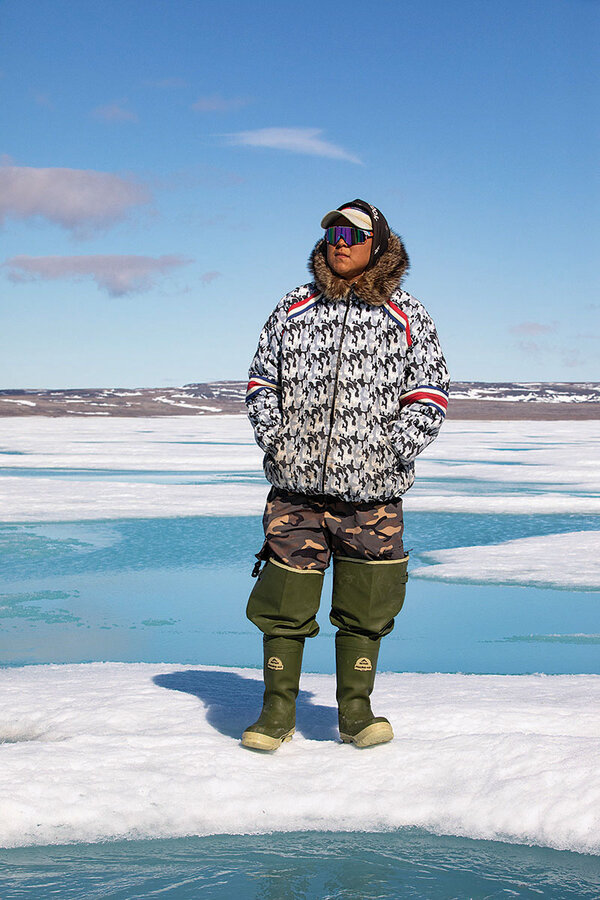
Atlas was one of the first youth we met for this series. Sara was in Turkey to cover the devastating earthquakes in February that killed at least 51,000 people. She stopped in Istanbul to meet with Atlas in Bebek Park, where he’d held his first climate protest.
Ms. Thunberg’s protests gave him a sense of awe and bravery, he says: “When she went to the parliament of Sweden ... and was there skipping school, climate striking ... I was shocked because she was [15].” He decided then, at age 11, that he, too, would become a climate activist.
It was a lovely sentiment, Sara remembers thinking. But he seemed so young, sitting there with his sign. Young, and also tiny next to his country’s big state apparatus and police force cracking down on protesters, smaller still next to the global complexity, politics, and economics of the climate crisis itself.
Sara wondered what, exactly, this high schooler hoped he could accomplish.
But as we stayed in touch with Atlas and got to know other young activists, we started to recognize they aren’t isolated protesters, but part of a global network.
It was Atlas who first sent us the WhatsApp number of Ina-Maria Shikongo – “Mama Ina,” as she’s known in climate circles – who has mentored young activists at her home in Namibia. It was Mama Ina who motivated the young teacher, Ms. Kandanga, to talk to those children outside of Windhoek about climate resilience. Ms. Kandanga, in turn, pointed us to Farzana Faruk Jhumu, a UNICEF youth climate advocate we met in Dhaka, Bangladesh.
They are part of an international web that is larger than many older people realize. And it’s one that many scientists feel is key to ushering in the changes they demand the world implement.
Climate scientist Myles Allen from the University of Oxford says he hopes their idealism doesn’t run aground as it did for so many protesters of the 1960s. “It’s important that although they’re activists they don’t settle for protest,” he says. “The hope is that they’ll keep this understanding of what’s going on with them as they actually enter into decision-making roles in government.”

“I don’t love the word ‘activist’”
Grace Gibson-Snyder looks something between exasperated and pained when asked if she considers herself a climate activist. A teenager, she is one of 16 young plaintiffs who won a landmark court decision last summer in a lawsuit claiming the state of Montana violated their constitutional rights to a healthy environment when it directed agencies not to consider potential climate impacts in setting energy policy.
“I don’t love the word ‘activist,’” Ms. Gibson-Snyder told Stephanie with a cringe at a coffee shop in mountain-chic Missoula, Montana. “I’m still struggling with that. ... [Lawsuits are] a very pro-institution way of working through this. ... We’re just saying the government should do what it’s supposed to do. To follow the constitution. It’s pretty simple.”
We heard that a lot. Look at it through one lens, and climate change is complex – an acronym-and-number stew of atmospheric science and integrated earth systems, of ocean currents and tipping points and parts per million and feedback loops.
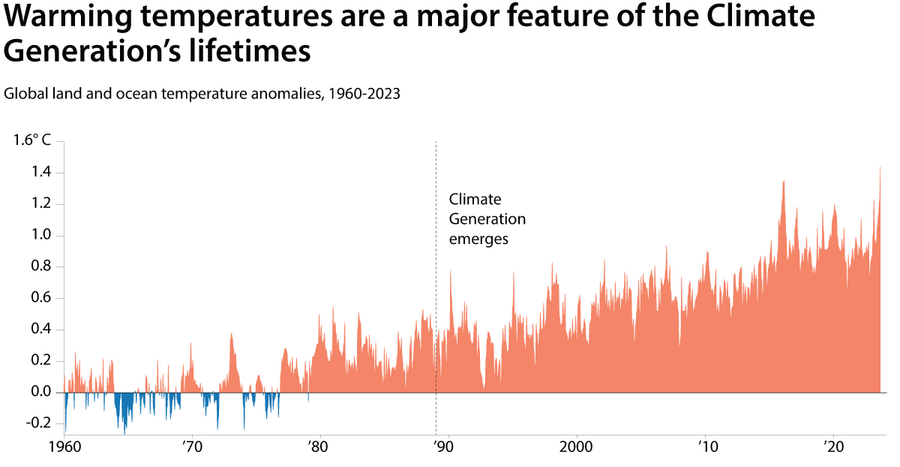
NOAA National Centers for Environmental Information
It’s also, in some ways, pretty straightforward: The world’s getting hotter. We should stop heating it.
The people elected to protect citizens should just start making decisions to protect citizens, many youth told us. Which means, they say, that those leaders should just stop adding to the problem with fossil fuels. In 50 years, some told us, a historian might look back at all the squabbling and hand-wringing and broken governmental promises and see a mind-boggling lack of common sense.
But this is a mindset, we thought, that only comes with a cohesively shared understanding of reality. And, for the most part, the Climate Generation has this when it comes to global warming.
Sixty percent of young Americans – Generation Z and millennials – say that they are alarmed or concerned about climate change, according to the Yale Program on Climate Change Communication, which for years has been tracking public perception about the issue.

Internationally, though, the number is higher – as close to universal as one can get. A global survey conducted by the advocacy group Plan International found that 98% of youth ages 15 to 24 are worried about climate change. And this shifts the generation’s choices in everything from what they eat to where they work.
Statistics show that 20% of people ages 18 to 24 in Britain don’t eat meat – primarily because of climate concerns. And in the broader United Kingdom, a fifth of children age 5 to 16 are vegan or want to be.
In Europe, many are “climate quitting,” as young people eschew working for automobile or energy companies to better align their work lives with their environmental values.
“Saying like, ‘I love this place, but what you’re doing is wrong,’ that is climate quitting. They are done, which is good for us,” explains Anne Kirmse, the head of human resources for Enviria, a startup helping German companies go solar. Sara chatted with her in Frankfurt, the banking capital of the European Union.
Not everyone has the ability to make such choices – and the Climate Generation realizes this.
The Climate Generation in the Global North is acutely aware of its carbon footprint – that it is using more than its share of the world’s resources. In other words, younger people – still so close to those basic kindergarten lessons of sharing and not taking more than one’s fair portion – understand there’s only so much greenhouse gas that can still be put into the atmosphere without causing ecological disasters. Divide that amount of gas by the number of people in the world, and that’s the fair amount of emissions – the size of the carbon footprint – that each individual should cause.
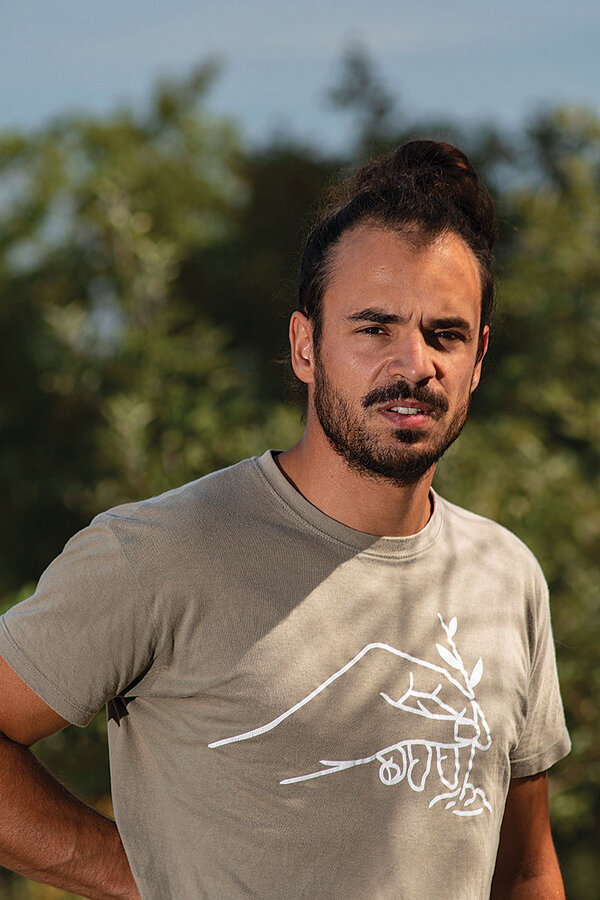
But in European nations, the U.S., and other wealthier countries, individuals emit far more than their share, largely because of their lifestyle habits of driving, flying, buying, and eating. In the U.S., for instance, using 2020 numbers, the average carbon footprint is about 16 tons – compared with the 4.5-ton global average that year, according to Climate Watch, an open data platform focused on climate statistics. In Germany, it is 8.19 tons. In Bangladesh, it’s 1.36. Many researchers say that to prevent the worst effects of climate change, the number should be, on average, 2 tons per person.
“I think about my responsibility for this because of my consumption – that people suffer because of my life standards in Europe,” says Daphne Hübsch, an 18-year-old from Frankfurt.
This isn’t just theoretical for Daphne. She has friends and peers from the Global South – in large part because of her new involvement as a climate activist.
Many young people from the Global South – in the Caribbean, Africa, and southern Asia – talked to us about their desire to have more power and voice, too.
When people in the Global North talk about the Global South, says Ms. Jhumu, the UNICEF advocate, it is “always that ‘they’re the most vulnerable. They don’t know how to cope with this, so we need to support them.’”
But, she adds, “we want to shift the narrative. We don’t want to show the world that we are finished, that we are doomed. We want to show there is hope and many solutions are already there.”
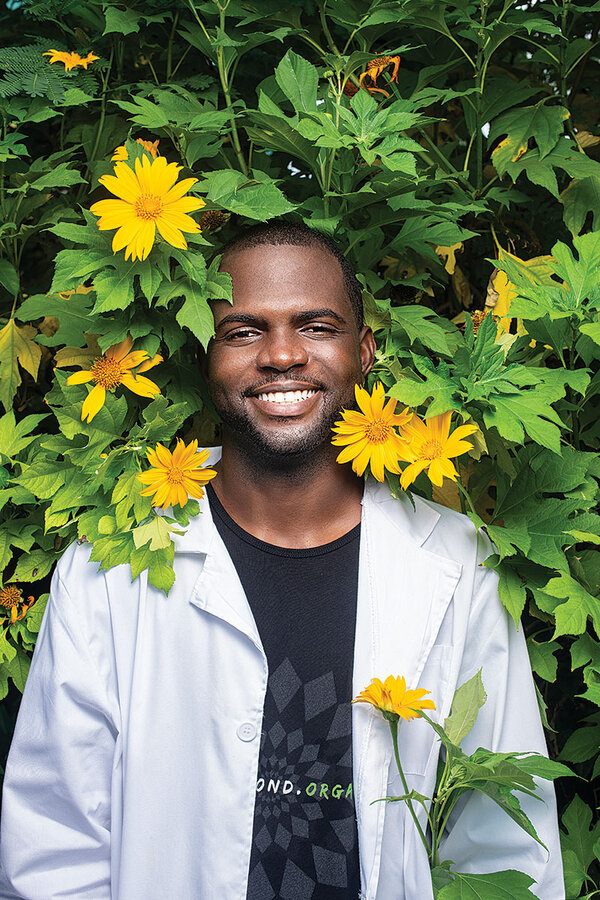
Likewise, Naomi Cambridge, a 21-year-old activist in Barbados, talks of how important it is for young people from small island nations to be heard on the international stage: “We are extremely vulnerable on a different level [than most people realize].” To build the best global solutions, she argues, power brokers must understand the perspective of young people in these places.
Inculcating a “green ethos” beyond the easy answers
Revolutions, we learned, can be quiet, almost imperceptible in the day-to-day.
While she was reporting in Montana, Stephanie spent a day following Ms. Yocum and her colleague, Bri Fain, as they tested river quality around Missoula. The 22-year-olds chatted about the pros and cons of roommates, about weekend rafting trips, the Bonnie Raitt concert they couldn’t afford, college classes, and moms tracking their children’s locations via iPhone.
They also both wondered aloud whether they’d feel right having their own children, given the changing climate.
That matter-of-fact sentiment struck us. So did their incongruously bubbly assertions that a sustainable world requires changes, but that it sometimes feels overwhelming to know what to do about it.
The young women don’t like the pattern of American consumption – but admit being tempted by the shiny objects on Instagram. They care about the fossil fuel load of what they eat but aren’t convinced of the easy answers of veganism or vegetarianism. They express a deep respect for Indigenous perspectives and practices and see humans as just one part of an ecosystem – the sort of mindset we saw in practice when Sara visited young members of the Indigenous Guardians of the Canadian Arctic.
They think the idea of never-ending expansion and consumption is ludicrous, as much part of a passé era as black-and-white television or cable. Like the young Portuguese farmers we met, they believe that smaller is better. Less is more.

They were, it seemed to us, mainstream representations of ideals that may have once seemed radical becoming the norm.
We wondered what this would mean for the youngest of the Climate Generation, those children born when the understanding of our future has already shifted.
At a tiny community garden, two dozen 4- and 5-year-olds from an impoverished neighborhood of Dhaka collect leaves and petals that have fallen to the muddy ground at the end of the rainy season and return to their one-room nursery school to make collages.
This “green play lab,” where plastic toys are getting phased out for those fashioned out of jute, bamboo, and clay, is in part an intentional effort to foster a “green ethos,” but it’s just as much a lesson about progress, explains Asif Saleh, executive director of BRAC, the nongovernmental organization behind the idea. “In a sense we all got kind of brainwashed a little bit by this Western consumerism, the whole notion was that prosperity and modernity means consumption and spending.”
But, “going back to the basics,” as he puts it, in this country that is among the world’s most affected by climate change, is their path to claim their right to a future. And it might be dawning here earlier because of geography, but the lesson applies globally. This year, after all, is shaping up to be the hottest ever recorded.
“For this generation,” he says, “there is no other alternative.”
This article was reported from Bangladesh, Barbados, Canada, Germany, Namibia, Portugal, Turkey, and the United States.

As Gaza toll rises, diplomatic and political costs mount for Biden
We wrote last week that pressure would mount on the United States the longer Israel’s massive counteroffensive continued. So it has, faster than anticipated. Does the U.S. prioritize humanitarian aims only when convenient? The Biden administration is scrambling to prove otherwise to allies at home and abroad.
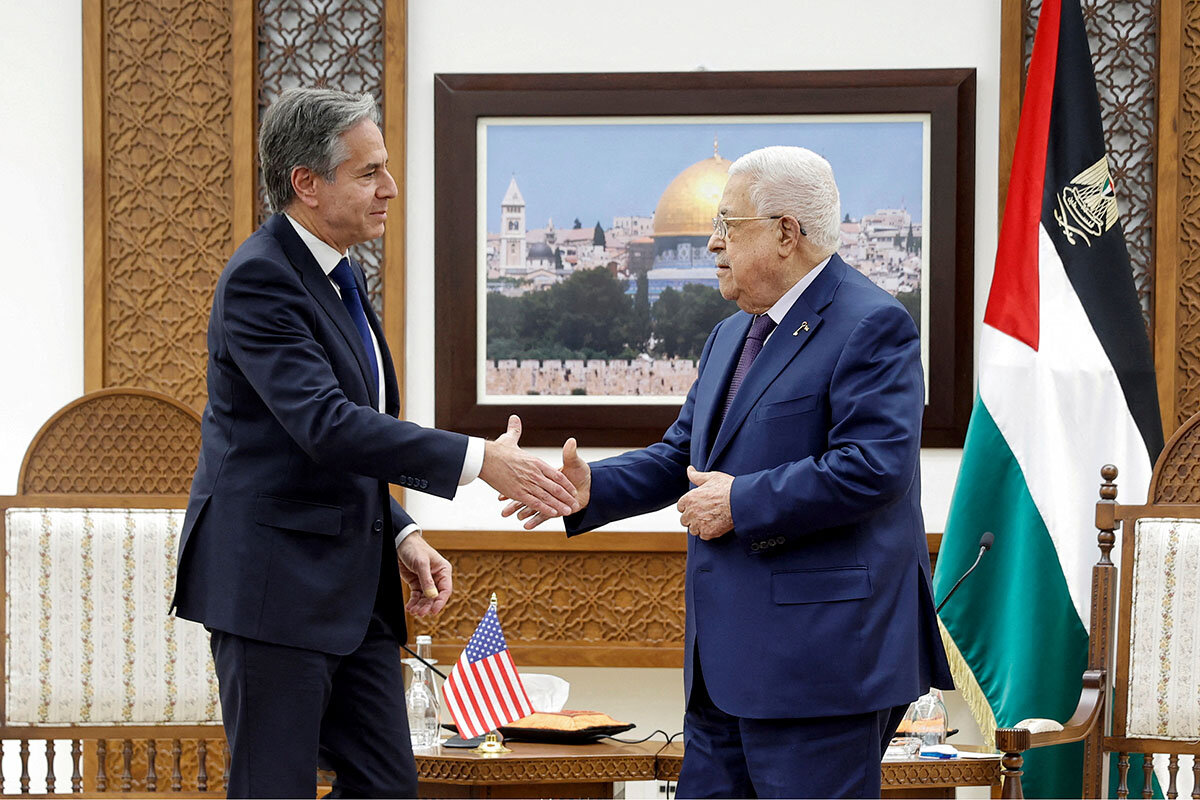
- Quick Read
- Deep Read ( 6 Min. )
As Israel pursues a relentless campaign aimed at destroying Hamas, and as Gaza’s humanitarian crisis deepens, the political winds that the Biden administration is facing at home and abroad have shifted significantly.
On the domestic front, the coalition that put President Joe Biden over the top in key states in 2020 – young people, African Americans, and other minorities including Arab Americans – is showing signs of unraveling. And overseas and especially among America’s Arab partners, opposition to Mr. Biden’s full embrace of Israel is intensifying.
“U.S. policy at the moment is stoking further anger in the Arab states and across the Global South, not least because it is seen as being hypocritical in its application of international law,” says Hugh Lovatt, a senior policy fellow at the European Council on Foreign Relations.
The United States is on a tightrope between its commitment to an ally at its moment of deep distress and its sense that the ally should be acting differently, he says.
“This is a very difficult U.S. balancing act, pursuing a two-track policy that consists of (1) hug Israel closely, and (2) influence Israel to modify its actions in its war and to open up more widely to humanitarian steps,” Mr. Lovatt says. “But ... in Arab capitals, they’re only seeing the first of these.”
As Gaza toll rises, diplomatic and political costs mount for Biden
When President Joe Biden gave a prime-time speech last month expressing his “ironclad” support for Israel in its war with Hamas, he spoke of Israel and Ukraine as two democracies in existential battles with despotic forces set on annihilating them.
He had good reason to think that framing Israel’s war in that context would work well for him.
After all, Mr. Biden’s staunch support for Ukraine rallied Western powers to Kyiv’s cause, and his Ukraine policy is widely viewed as a standout foreign policy success.
Moreover, bipartisan support for Israel has historically been very strong.
But things aren’t turning out the way the president might have imagined.
With the death toll in Gaza reportedly surpassing 10,000 Monday as Israel pursues a relentless campaign aimed at destroying Hamas, and as Gaza’s humanitarian crisis only deepens, the political winds at home and abroad – and in particular in the Middle East – have shifted significantly.
On the domestic front, the coalition that put Mr. Biden over the top in key states in 2020 – young people, African Americans, and other minorities including Arab Americans – is showing signs of unraveling.
Michigan is a case in point. Recent polls show support for President Biden plummeting in the state’s sizable Arab American community, whose overwhelming support in 2020 played an outsize role in delivering the battleground state to the blue column.
And overseas and especially among America’s Arab partners, opposition to Mr. Biden’s full embrace of Israel is intensifying – as Secretary of State Antony Blinken learned this weekend.
Meeting with Arab leaders in Jordan Saturday after a stop Friday in Israel, Mr. Blinken heard demands for a cease-fire in Gaza – something Israeli Prime Minister Benjamin Netanyahu has ruled out – while receiving a message that the United States is not doing enough to pressure Israel to modify its onslaught in Gaza, home to more than 2 million Palestinians.
“U.S. policy at the moment is stoking further anger in the Arab states and across the Global South, not least because it is seen as being hypocritical in its application of international law,” says Hugh Lovatt, a senior policy fellow in Middle East affairs at the European Council on Foreign Relations in London.
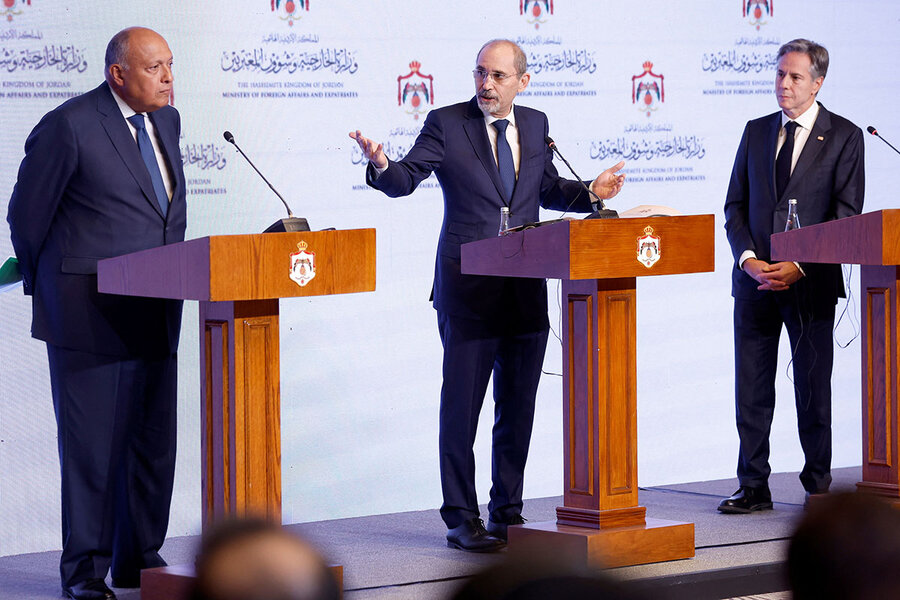
Hypocritical, he says, because the U.S. is not seen to be demanding that its ally Israel adhere to international humanitarian law and rules of war so soon after calling on the world to support Ukraine against Russia’s invasion based on international law.
The U.S. is on a tightrope between its commitment to an ally at its moment of deep distress – following the slaughter of 1,400 people in Hamas’ Oct. 7 attack – and its sense that the ally should be acting differently now for everyone’s long-term good, he says.
“This is a very difficult U.S. balancing act, pursuing a two-track policy that consists of (1) hug Israel closely, and (2) influence Israel to modify its actions in its war and to open up more widely to humanitarian steps,” Mr. Lovatt says. “But the nuance is lost in the Middle East; in Arab capitals, they’re only seeing the first of these.”
Some U.S. officials admit privately to a growing frustration with Israel over its refusal to act on U.S. counsel both to modify its military campaign aimed at rooting Hamas out of Gaza, and to move more deliberately on easing what many experts say is a looming humanitarian catastrophe there.
Some reliable administration (and Israel) supporters are beginning to publicly express misgivings over Israel’s conduct of the war.
Last week Sen. Chris Murphy, a Connecticut Democrat, called on Israel to “shift” its strategy, saying events including a deadly strike on a refugee camp suggest that Israel has “not struck the right balance between military necessity and proportionality.”
Secretary Blinken presented Israel with President Biden’s proposal for humanitarian “pauses” in the military campaign, which would allow for more humanitarian aid to get into Gaza and for negotiations aimed at freeing the more than 240 hostages being held by Hamas.

But Mr. Blinken was unable to report any progress on humanitarian pauses to Arab leaders – who in any case are pressing for a full cease-fire, something Mr. Netanyahu says will not happen at least until all the hostages are released. The leaders also told the secretary that instead of destroying Hamas, Israel’s war is more likely to create a new generation of religious extremists that will mean more trouble for everyone in the region, including Israel.
During a surprise stop in Baghdad Sunday, Mr. Blinken told journalists that getting to humanitarian pauses is a “process” that will take more time.
“Israel has raised important questions about how humanitarian pauses would work,” he said. “We’ve got to answer those questions.”
Still, many experts assume that at some point at least some form of pause in hostilities will come.
“The history of Gaza is a history of cease-fires called something else,” says Jon Alterman, senior vice president and director of the Middle East Program at the Center for Strategic and International Studies in Washington.
“The U.S. view is that if the Israelis stop [the military campaign] for some set time, it will allow more humanitarian aid to get in and space to negotiate freedom of some hostages,” Dr. Alterman says. “The U.S. has a lot of room to pressure Israel. The question is whether that pressure will have a desired effect.”
“Many American officials feel the U.S. learned a lot from the Iraq War and the Afghanistan War, and they’re sharing that with the Israelis,” he adds. “The Israeli response is that those experiences aren’t relevant to our particular situation.”
Whether President Biden can demonstrate enough influence with Israel to begin altering perceptions of him in key audiences at home and abroad remains to be seen, a variety of experts say.
Mr. Biden is a “very tactile president” who “lives for these moments of high pressure to figure out how to move people to where you want them to go,” Dr. Alterman says.
The problem is that while the president works the “process” of trying to transform influence with Israel into actions, key communities he needs at home and abroad are souring on him.

“The administration needed to figure out how to walk a tightrope between support for Israel” and pursuing long-term U.S. interests, “but instead it’s been a full bear hug [of Israel] with no counterbalancing actions,” says James Zogby, president of the Arab American Institute in Washington.
President Biden has made a number of public “mistakes” that have sent his support among Arab Americans plummeting, Dr. Zogby says, including casting doubt on the high Palestinian death toll in Gaza because the numbers are from the Gaza Health Ministry, an agency of the Hamas government.
“It’s insulting, and it suggests Palestinian lives matter less than others,” he says. “The sense of betrayal in Arab American communities is strong enough that it could make a decisive difference next year in states like Michigan and Pennsylvania,” he adds.
Indeed, a sense of U.S. complicity in what is seen by some as Israel’s disregard for civilian lives in Gaza was a common theme in large pro-Palestinian demonstrations this weekend both in the U.S. and around the world.
At the less emotional policy level, Dr. Zogby says frustration is building with the Biden administration for not pushing Israel harder to conduct its military campaign and articulate an endgame in a way that can draw in Israel’s Arab neighbors instead of alienating them.
Some say Israel, having developed stronger ties with some Arab states, is at risk of squandering regional support it’s going to need.
“The Arab states are unified in two things: an abhorrence of Hamas, and disgust at how Israel is carrying out this war with Hamas,” Dr. Alterman says. “Israel needs to be mindful of this because it’s going to need to establish a sense of partnership with the Arab neighbors on a postwar Gaza. And the U.S.,” he adds, “needs to be reminding the Israelis of this early and often.”

In fraud trial, Trump brings his campaign to the courtroom
In the legal proceedings against him, former President Donald Trump has largely avoided taking the stand. At a New York fraud trial today, he spoke. The takeaway? Whether he’s in a courtroom or on the campaign trail seems to make no difference. Mr. Trump’s message and manner remain the same.

- Quick Read
- Deep Read ( 3 Min. )
Former President Donald Trump frequently attacks the multiple legal cases against him as political attempts to impede his presidential campaign. But in many ways, it’s Mr. Trump who appears to be bringing the campaign into the courtroom – to possibly advantageous effect.
On Monday, Mr. Trump took the stand in his civil fraud trial in New York and gave expansive answers in which he portrayed himself as a victim, Attorney General Letitia James as a political hack, and the judge overseeing the trial as biased.
That judge, Arthur Engoron, at one point exasperatedly asked one of Mr. Trump’s lawyers to control his client and get the former president to answer the specific questions about the case.
“This is not a political rally,” said Judge Engoron.
Attorney General James is asking for $250 million in damages and a prohibition on the Trump family doing business in the state. She charges that Mr. Trump, his adult sons, and other co-defendants committed fraud by exaggerating the value of real estate assets on financial statements to get better terms on loans and insurance.
Prior to the beginning of testimony, Judge Engoron ruled that evidence shows the Trumps were indeed guilty of “persistent and repeated” fraud. He will rule on damages, which could include the Trumps losing control of signature properties, after the trial concludes.
In fraud trial, Trump brings his campaign to the courtroom

Former President Donald Trump frequently attacks the multiple legal cases against him as political attempts to impede his presidential campaign. But in many ways, it’s Mr. Trump who appears to be bringing the campaign into the courtroom – to possibly advantageous effect.
On Monday, Mr. Trump took the stand in his civil fraud trial in New York and gave expansive answers in which he portrayed himself as a victim, Attorney General Letitia James as a political hack, and the judge overseeing the trial as biased.
That judge, Arthur Engoron, at one point exasperatedly asked one of Mr. Trump’s lawyers to control his client and get the former president to answer the specific questions about the case.
“I do not want to hear everything this witness has to say. He has a lot to say that has nothing to do with the case,” said Judge Engoron.
“This is not a political rally,” he added.
The former president later attacked the judge for his comments, posting a picture of him on his social media site Truth Social, with the quote, “No, I’m not here to hear what [President Trump] has to say.”
Attorney General James is asking for $250 million in damages and a prohibition on the Trump family doing business in the state. She charges that Mr. Trump, his adult sons, and other co-defendants committed fraud by exaggerating the value of real estate assets on financial statements to get better terms on loans and insurance.
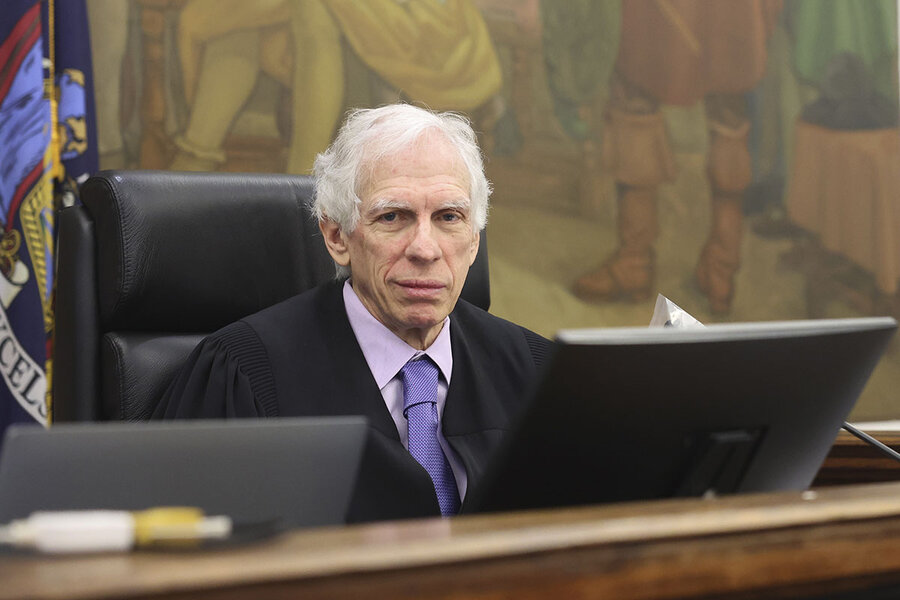
Prior to the beginning of testimony, Judge Engoron ruled that evidence shows the Trumps were indeed guilty of “persistent and repeated” fraud. He will rule on damages, which could include the Trumps losing control of signature properties, after the trial concludes.
During a long day of testimony on Monday, Mr. Trump was at times combative. At several points he seemed to be speaking past the judge and lawyers in the courtroom to a larger public beyond.
“It’s a terrible thing you’ve done,” Mr. Trump said to Judge Engoron at one point. “You know nothing about me.”
Later he took a paper from his pocket and asked to enter it into the record. Judge Engoron stopped him.
“This is a very unfair trial. ... I hope the public is watching,” Mr. Trump said.
A number of times, the former president raised what he called the “worthless” clause in his own defense. This referred to disclaimers on many of his financial statements that stated banks and other recipients needed to do their own work to verify provided numbers.
Judge Engoron already discredited the use of this defense in his pretrial ruling, saying the disclaimers don’t contain the word “worthless,” do not rise to the level of an enforceable clause, and cannot be used to insulate against intentional fraud.
Mr. Trump also said that many of the financial statements were the work of outside accounting firms – a defense invoked by his sons Donald Jr. and Eric as well.
The former president said he would sometimes look over the statements with his advisers and make “suggestions” as to the value of some properties.
Overall, Mr. Trump’s testimony did not appear to reflect a purely legal strategy, tweeted former federal prosecutor Renato Mariotti. It took into account public relations – and politics – as well.
“Trump wants to convince his followers the trial is rigged and that he’s a victim, not a fraudster,” Mr. Mariotti wrote on the social media site X, formerly known as Twitter.
After the proceedings were over, Attorney General James said that despite the former president’s “distractions” in his testimony, “the numbers don’t lie.”
Mr. Trump’s approach to his civil trial and upcoming criminal trials does not appear to have hurt him in the polls. If anything, his political position has strengthened: A recent New York Times/Siena poll finds the former president ahead of President Joe Biden in five of six key battleground states.

Why French schools are turning to lessons in empathy
The world is awakening to the fact that bullying is not just kids being kids. In France, that awakening happened last spring when a 13-year-old girl died by suicide. Finding the right response has been hard. But schools are making progress, and others are stepping in to help, too.

- Quick Read
- Deep Read ( 6 Min. )
France has been shocked by a recent spate of suicides among young people that has renewed debate in the country over how to reduce the bullying that can drive school kids to kill themselves. Studies show that 1 in 10 French children suffer from school abuse.
One central theme has been a government drive to punish the harassers, not the victims; the latter often suffer from being taken out of their schools, which are familiar environments.
And calling out bullies is effective, says Caroline Veltcheff, an adviser on harassment to the Paris school district. “Meeting the harasser and others who might laugh along, explaining the situation ... works really well to help kids build awareness, and oftentimes they just stop,” she says.
At the same time, actors, politicians, and young people themselves are telling their own stories of school harassment in public, reducing some of the stigma attached to those who suffer from bullying.
Outing harassment publicly is essential to eradicating it, says Marjorie Revy, who herself suffered brutal harassment at school and who now runs a nonprofit to share her story with students.
“When you make fun of someone, you never know the harm you could be causing,” she says.
Why French schools are turning to lessons in empathy

Marjorie Revy was first harassed in elementary school. It began with teasing – about how she knew how to read before everyone else – but quickly turned physical, even violent.
For five years, she says, she was regularly sideswiped in the hallways, tripped, and pushed down the stairs. When she was 10, a boy purposely kicked a soccer ball at her face, breaking her nose. Her harassers turned swaths of the school against her. When she tried to report the abuse, her teachers brushed her off, telling her she was exaggerating.
“Imagine the worst school harassment and I’m 98% sure I experienced it,” says Ms. Revy, now 25. “For two years, I sat in silence.”
Ms. Revy started suffering from anxiety and depression, and refused to go to school. At the end of fourth grade, her parents pulled her out and she started private lessons at home. A half-dozen of her parents’ friends came over regularly as part of a makeshift suicide-watch team.
“I didn’t know how to kill myself, but I knew how to make myself fall asleep,” says Ms. Revy. “Later, I found notes I had written about wanting to die. My dad told me recently that his worst fear when he came home from work was that the house would be silent.”
Now, Ms. Revy is working to make sure other kids don’t suffer as she did. Her nonprofit, Athénaïs, which she created with her father last year to share her story with schoolchildren and young adults, is one of many working alongside the French government to fight bullying in schools. Nonprofits say at least 1 in 10 French students suffer school abuse, and France has seen a spate of youth suicides – including one already this school year.
The outpouring of emotion over the deaths – with some as young as age 13 – has created a #MeToo-like moment; actors, politicians, and young people themselves are telling their own stories of school harassment in public.
Now, more French schools are asking themselves how they can build more resilient kids and break the silence cloaking such harassment.
Anti-bullying efforts are putting a new focus on punishing the bullies, rather than taking steps that punish victims by removing them from the familiar environments of their schools. But some say France’s current educational environment makes it hard for kids and parents to report abuse, and there is a debate about just how bullies should be punished.
“Is there more harassment than before? I don’t know, but there’s definitely more awareness,” says Justine Atlan, executive director of E-Enfance, a nonprofit that works to protect children and operates France’s national harassment help line. “Parents know harassment is not allowed and young people know that if they’re faced with a situation, they have the right to ask for help. Now we just need the resources to put plans into action.”
When the victims are punished
The French government has made school harassment a national cause since a 13-year-old named Lindsay died by suicide last spring in the Pas-de-Calais region after months of abuse.
The prime minister introduced a series of measures to combat the problem: recruit more school psychologists, oblige school principals to report harassment, provide more teacher training, and target online harassment.
But in September, on the second day of school, 15-year-old Nicolas killed himself in the suburbs of Paris. His parents say they had alerted the education authorities to their son’s harassment at school on numerous occasions, but that the only response had been a warning to adopt a “constructive and respectful attitude” toward educators or risk penal consequences.
Nicolas’ death caused uproar across France, sparking new debate over how best to deal with bullies and their victims.
That is an issue that angers Virginie, a mother in the south of France, whose youngest daughter faced harassment at school five years ago when she was 13. She suffered from repeated illness due to the stress.
“I confronted the kids who were harassing my daughter, told the school, and sent letters to the education authority,” says Virginie, who asked not to be fully identified to protect her daughter. Their response was to suggest she hold her daughter back a year, to avoid her aggressors.
“In the end, my daughter was the one who was punished,” she says.
The French government says it wants to make sure situations like this never happen again. It has expanded its existing anti-harassment school program and introduced several new measures that focus on prevention, detection, and solutions.
Harassers will now have their cellphones confiscated, be banned from social media, and be forced to change schools if necessary. In extreme cases, the law will intervene.
In late September, police handcuffed and removed a 14-year-old student in the middle of class, following complaints that he was inciting a transgender student to die by suicide. The incident created a heated debate about the lengths to which law enforcement should be used in cases of school harassment.
“Police and the judicial system should only be used when all other options have been exhausted,” says Caroline Veltcheff, the adviser to the Paris school district on school harassment. “The goal is to break up the harasser’s group dynamic. That means meeting the harasser and the others who might laugh along, and explaining the situation.
“You’re not necessarily looking for the cause of the harassment, just that it stops,” she adds. “This works really well to help kids build awareness and oftentimes, they simply stop.”
At least online, “once harassers receive punishment and become aware of the effect of what they’re doing, they just stop,” she says. In a 2020 study of online harassment by E-Enfance, 9 times out of 10, harassers recognized their acts after facing consequences.
Teachers should be polite, too
Bullying is most common in junior high, say experts, who are urging the government to introduce preventive measures well before then. Last year, a test group of preschools began rolling out courses in empathy, based on a 20-year-old Danish teaching model called Fri for Mobberi – “free from harassment.” The government aims to make the classes mandatory nationwide by the 2024-25 school year.
Already, a growing number of French schools have started exploring alternative ways of learning that focus on well-being and confidence-building. But some say French schools should change the way they operate if they want to see change in student behavior.
“Teachers can’t just have one class on empathy per week and call it a day. They have to practice what they preach,” says Cécile Vienot, a Paris-based child psychologist. “If a teacher ... asks students to be polite but then doesn’t even say hello to them in the hallway, it creates ... an environment of disdain. We need to take baby steps on this to move forward.”
Since 2015, the French education ministry has experimented with student ambassadors who are trained to spot harassment and help resolve conflicts. Ms. Veltcheff, the school harassment adviser, says the training makes students “not just the problem but the solution.”
Giving students more autonomy in dealing with harassment could help schools manage scarce resources. The government cut 1,500 teaching jobs at the start of this year, and France has one of the highest student-teacher ratios in Europe – 26.6 per class compared with the average of 21 across the Continent.
In the meantime, public awareness about the detrimental effects of school harassment is growing. Many victims have taken to X, formerly known as Twitter, to recount their stories using the hashtag #CaAuraitPuEtreMoi – “It could have been me.” Last September, French Deputy Virginie Lanlo gave a speech in Parliament about her own experience of school harassment.
Outing harassment publicly, says Ms. Revy, is essential to eradicating it. While her nonprofit work in schools hasn’t yet allowed her to fully turn the page, it is certainly helping her and her family process her school trauma.
“When you make fun of someone, you never know the harm you could be causing,” says Ms. Revy, who, despite dropping out of school at age 18 due to her school phobia, has since finished high school and is currently attending college. “For my entire childhood, I looked for ways to kill myself. Today, I’m happy. But the pain is still there.”

Essay
Please don’t buy my books
Does anyone really need three copies of Stephen King’s “The Dark Tower I: The Gunslinger”? In this essay, one woman’s get-rich-quick scheme to sell her own books ends in abject failure, because every book is precious. Maybe two copies of “The Gunslinger” are enough. Maybe.

- Quick Read
- Deep Read ( 3 Min. )
-
By Bev Potter Contributor
Like everybody else in America, I was looking for a side hustle. I leafed idly through one of my four copies of “Infinite Jest,” and an idea slowly formed. I could sell all of the hundreds of books I’ve compulsively purchased over the years and never quite gotten around to.
I started out strong, selling one copy of Stephen King’s “The Dark Tower I: The Gunslinger.” I shipped it to Colorado – at a loss.
And even though I owned three copies of it, I felt ambivalent about letting it go. I loved the feel of the slick cardboard cover in my hands and the smell of the musty paper it was printed on. I loved the memories of where I was in my life when I first bought it at a mall bookstore.
The mall is gone. And now the book is.
But each book reminds me that authors live forever through their work. Each book, too, reminds me of a younger me, and I don’t want to let that younger me go.
So, please, whatever you do, don’t buy my books.
Please don’t buy my books
Like everybody else in America, I was looking for a side hustle. Something to make a few extra bucks so I can afford my favorite grande cappulatte Machu Picchu with xtra xpresso.
So I read all the clickbait articles about taking surveys (for pennies) or becoming a remote receptionist (too much work). I even briefly considered delivering pizza but realized I’d be fired after the first night for picking all the pepperoni off of customers’ pizzas and leaving just the naked dough.
I looked around my house for inspiration, peering over and around the piles of books tottering like enormous games of Jenga. “Maybe I can sell my clothes. Surely somebody would want the Size 6 Calvin Kleins I wore in high school. They’re vintage. I can’t get them past my knees.”
I leafed idly through one of my four copies of “Infinite Jest” (which I’ve never read), and an idea slowly formed. I could sell books. My books. No, not books I’ve actually written, but all of the hundreds of books I’ve compulsively purchased over the years and never quite gotten around to. Like “Candide” and “The Gulag Archipelago,” both of which feel like homework. Or real page-turners like “Zen and the Art of Motorcycle Maintenance,” which I presume is about mindfulness and small-engine repair, neither of which interests me.
I watched a YouTube video by somebody who was (allegedly) earning $3,000 a month selling books online. I was sold.
Since all roads lead to Amazon, I requested permission to join Amazon Marketplace.
All I had to do now was choose which books to sell, post them to my account, ship them off to my millions of happy customers, and watch the money roll in.
I needed a system. Piles are, technically, a system. But I needed different piles. I needed “keep” and “sell” piles.
I started out strong because I own three copies of Stephen King’s “The Dark Tower I: The Gunslinger.” No, I don’t know why.
It was easy enough to post a copy to Amazon and follow it up with several other less-than-beloved books like Sir Thomas More’s “Utopia” and Gary Zukav’s “The Dancing Wu Li Masters.”
After a certain age, you forget about the person you used to be. Apparently, I was a person who thought deep thoughts and bought books like Gary Zukav’s “The Dancing Wu Li Masters.”
Part of me wishes I was still that person. Someone with intellectual curiosity and without the fatal allure of the internet calling to me like the sirens of Homer’s “The Odyssey,” which I also haven’t read, but I think I’ve got a copy lying around somewhere and I know there are sirens in it and something about a sheep.
But I forgot about all that when I discovered that my copy of Steve Martin’s 1977 masterpiece “Cruel Shoes” is worth $35.
Should I hang onto it? Maybe I should hang onto it. It can only appreciate in value, right? What if Steve Martin dies? Well, not if, but at least before me. The price will go through the roof. My copy of “Cruel Shoes” will become memorabilia. And everybody knows memorabilia is worth more than ordinary stuff.
And what about all these other books I’ve never read? I should read them first, and then I’ll sell them.
A year has gone by. I’ve added a measly 10 books to the “sell” pile, and only after the kind of tortured internal debate usually reserved for buying a new home.
I sold one copy of “The Gunslinger” and shipped it to Colorado at a loss.
And even though I owned three copies of “The Gunslinger,” I felt ambivalent about letting it go. It was a book, and I loved it. I loved the feel of the slick cardboard cover in my hands and the smell of the musty paper it was printed on. I loved the memories of where I was in my life when I first bought it at a mall bookstore.
The mall is gone. And now the book is.
But each book reminds me that authors live forever through their work. Each book, too, reminds me of a younger me, and I don’t want to let that younger me go.
So, please, whatever you do, don’t buy my books.
Other headline stories we’re watching
(Get live updates throughout the day.)The Monitor's View
Sprouts of peace amid shots of war
- Quick Read
- Deep Read ( 3 Min. )
-
By the Monitor's Editorial Board
As Israel escalates its counteroffensive against the Hamas military in Gaza, another intense effort has begun in the Middle East. It is one that favors a strategy of nonviolence and builds off rising sentiments against the futility of violence to resolve grievances or claim dominance.
Diplomats, for example, are shuttling between capitals to seek a consensus on a “humanitarian pause” in the Gaza fighting. The Palestinian Authority that rules the West Bank has reasserted its commitment to peaceful tactics as one reason for it to govern postwar Gaza. And in a bold statement Oct. 26, nine Arab countries rejected “attacks on civilians, all acts of violence and terrorism against civilians.”
Polls in the region by Arab Barometer over many years have shown a drop in acceptance of violence for political purposes. And while the Palestinian cause for a homeland remains popular in much of the Arab world, a Washington Institute poll in July found “attitudes toward the terrorist groups attempting to claim it are decidedly unpopular.”
As Israel seeks a military solution to the Hamas use of intentional violence against civilians, peaceful tactics are competing to resolve this recurring conflict.
Sprouts of peace amid shots of war
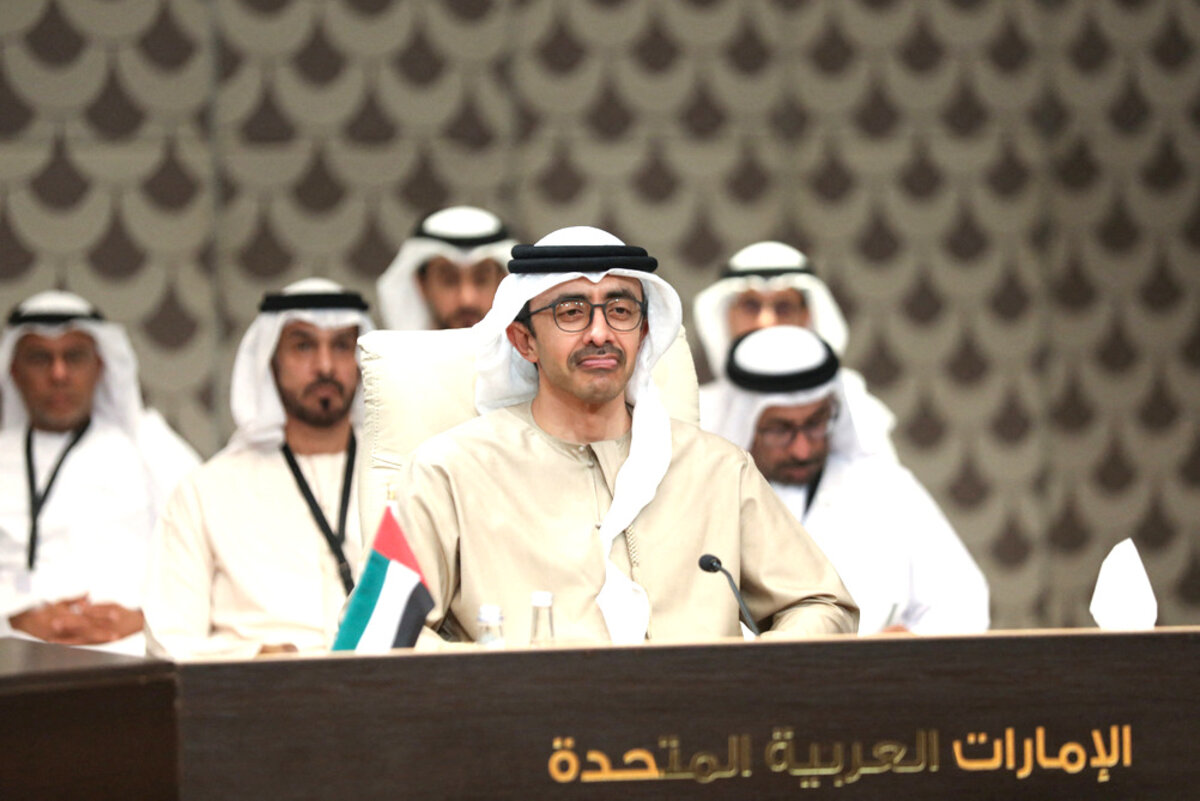
As Israel escalates its counteroffensive against the Hamas military in Gaza, another intense effort has begun in the Middle East. It is one that favors a strategy of nonviolence and builds off rising sentiments against the futility of violence to resolve grievances or claim dominance.
Diplomats, for example, are shuttling between capitals to seek a consensus on a “humanitarian pause” in the Gaza fighting. The Palestinian Authority that rules the West Bank has reasserted its commitment to peaceful tactics as one reason for it to govern postwar Gaza. And in a bold statement Oct. 26, nine Arab countries rejected “attacks on civilians, all acts of violence and terrorism against civilians.”
Note the “all acts of violence.” In decades past, many of those states – Egypt, Jordan, the United Arab Emirates, Bahrain, Saudi Arabia, Oman, Qatar, Kuwait, and Morocco – might have supported an attack on Israel like the one by Hamas on Oct. 7, or even joined in. Not at this historic moment.
To be sure, Arab leaders face pressure from mass protests against Israel’s attacks on Hamas targets that have led to large civilian casualties. Yet tellingly, the protests have been largely nonviolent. Polls in the region by Arab Barometer over many years have shown a drop in acceptance of violence for political purposes. And while the Palestinian cause for a homeland remains popular in much of the Arab world, a Washington Institute poll in July found “attitudes toward the terrorist groups attempting to claim it are decidedly unpopular.”
“The peaceful nature of this wave of Arab mass mobilization reflects a growing trend to renounce violence as a means of pursuing political objectives and a desire for stability following the turbulent years following the 2011 Arab Spring,” writes Amr Hamzawy, a senior fellow and the director of the Carnegie Middle East Program in Washington and a former member of Egypt’s Parliament.
“Together, the mainstream Arab public space put forward pro-peace and pro-life values without any attempt to justify Hamas actions – neither with references to the ongoing occupation and siege of the Palestinian territories nor by evoking militant Islamist anti-Jewish rhetoric that has lost its popular appeal in recent years,” Mr. Hamzawy added.
This trend toward nonviolence in the Arab street, Mr. Hamzawy states, may be the “launchpad for a possible revival of the peace process between Israelis and Palestinians, with wide Arab backing for the first time.”
Just before the Oct. 7 attack, one Palestinian peace activist based in Jerusalem, Professor Mohammed Dajani Daoudi, told a crowd in New York City why he remains optimistic about nonviolent ways to bring Arabs and Israeli Jews together. He said he has learned to leave the past and the present to historians and deal with the future.
“We have inherited from our grandparents this conflict, and so it is our duty to plant seeds of love, seeds of peace, so that we can leave a different inheritance to our grandchildren,” he said.
As Israel seeks a military solution to the Hamas use of intentional violence against civilians, peaceful tactics are competing to resolve this recurring conflict.

A Christian Science Perspective
Each weekday, the Monitor includes one clearly labeled religious article offering spiritual insight on contemporary issues, including the news. The publication – in its various forms – is produced for anyone who cares about the progress of the human endeavor around the world and seeks news reported with compassion, intelligence, and an essentially constructive lens. For many, that caring has religious roots. For many, it does not. The Monitor has always embraced both audiences. The Monitor is owned by a church – The First Church of Christ, Scientist, in Boston – whose founder was concerned with both the state of the world and the quality of available news.
The lifesaving power of daily prayer
- Quick Read
- Read or Listen ( 3 Min. )
-
By Margaret Rogers
Praying daily establishes within us a firm foundation, from which we can help and heal in even the most dire situations.
The lifesaving power of daily prayer
An account reported in The Christian Science Monitor earlier this year inspired me to consider deeply the power of committed daily prayer. The section of the report subheaded, “The compassion in seeing everyone in a new light,” tells about Antoinette Tuff, who worked as a bookkeeper at a school in Georgia. She had a practice of reading the 23rd Psalm – which begins, “The Lord is my shepherd; I shall not want” – early each morning. Although she was facing serious marital and financial troubles at the time, Ms. Tuff said starting her day with God helped her leave home “in a peace when the wind is raging.”
The article reports that early one morning when Ms. Tuff was in the front office at work, a man walked in carrying an AK-47 and announced, “We’re all going to die today.” Ms. Tuff was frightened, but her motherly instinct led her to talk with the 20-year-old gunman. She recalled telling him, “Mmm-mm, we’re not doing that today.” While on the phone with 911, she assured him, “We’re not going to hate you, baby,” and “It’s going to be all right, sweetie – I just want you to know that I love you though, OK?” The young man ultimately surrendered to the authorities, and no one was hurt. (See Christa Case Bryant, “Citizen problem-solvers: Advice to the new Congress on gridlock,” Jan. 3, 2023.)
How much the world needs people prepared to comfort and heal. To begin each day with prayer that affirms the presence of an all-loving, governing intelligence that is God is perhaps the most important preparation we can make to productively meet whatever comes our way.
Scriptural texts are a strong foundation for prayer. I love to pray with a spiritual interpretation of the 23rd Psalm written by the Monitor’s founder, Mary Baker Eddy. It begins, “[DIVINE LOVE] is my shepherd; I shall not want.
“[LOVE] maketh me to lie down in green pastures: [LOVE] leadeth me beside the still waters.
“[LOVE] restoreth my soul [spiritual sense]” (“Science and Health with Key to the Scriptures,” p. 578).
Spiritual sense could be described as a conviction that God is all-inclusive Love, more powerful than fear or threats of any kind. As another psalm puts it, “God is our refuge and strength, a very present help in trouble. Therefore will not we fear” (Psalms 46:1, 2).
Spiritual sense is natural to us as God’s offspring, but it needs to be cultivated. Anyone who prays regularly to know and feel God’s ever-present care has a basis from which to rise above fear and to be calm, strong, and helpful. However buried this spiritual sense may appear to be in ourselves or others, it is the truth of everyone’s being as an expression of God. Becoming conscious of our spiritual sense through daily prayer and meditating on spiritual truth prepares us to better respond to people’s natural yearning for healing love.
I experienced the power of daily prayer during a threatening situation when I was in college. While I was studying alone one evening in a secluded place, a man approached and told me he was going to rape me. I felt terrified, but right away it came to me to say that God was his Father and mine, so I was his sister, and he didn’t want to hurt me. I confess I sounded calmer than I felt, but the words calmed the man. My practice of daily prayer – including the Lord’s Prayer, which begins, “Our Father” – enabled me to speak to him in a way that reached his heart. He began to cry and tell me some of his problems. I told him that God loved him. Soon he left without touching me.
Taking time each day to establish God’s reality, presence, and love for all creation is a rock in times of trouble. It keeps us ready to bring healing to all situations.
A hymn describes this kind of lifesaving prayer:
A whispered word may touch the heart
And call it back to life;
A look of love bid sin depart
And still unholy strife.
(“Christian Science Hymnal,” No. 303)

Viewfinder
An earthquake’s aftermath
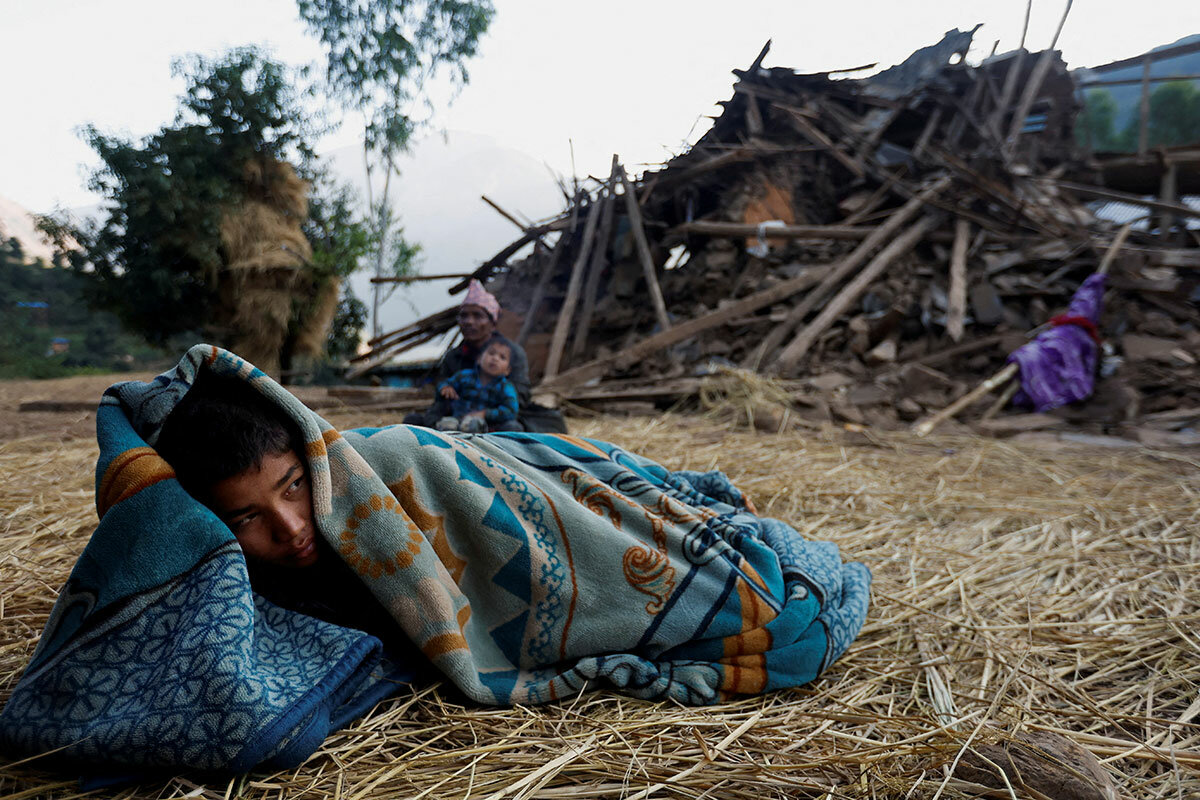
A look ahead
Thanks for joining us today. Tomorrow, we’ll take a look at a gun rights case before the United States Supreme Court.
Last week, we wrote about how American communities are shifting the conversation around mass shootings to a right to public peace. The case the Monitor’s Henry Gass examines tomorrow will be crucial in determining how far communities can go in passing gun laws. Can jurisdictions seize weapons from domestic abusers subject to restraining orders? Be sure to come back and give it a read.



